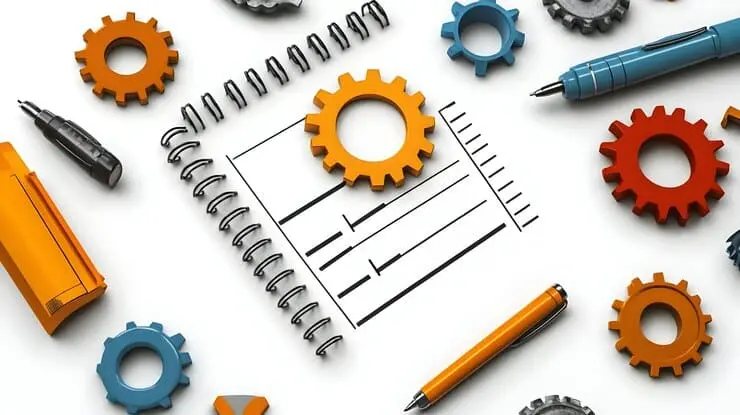This blog post explores various continuous improvement tools and their significant benefits for enhancing business processes and efficiency. It also provides real-life examples of how these tools have been successfully implemented in different organizations to drive continuous improvement. KPI Fire’s Continuous Improvement Software is highlighted as an essential solution that integrates these tools, offering a single source of truth and actionable insights to help companies streamline their processes, drive program execution, and achieve measurable cost savings.
Understanding Continuous Improvement Tools
Continuous improvement tools are essential for organizations seeking to identify and eliminate waste, improve efficiency, and enhance quality. These tools provide a structured approach for analyzing processes, identifying areas for improvement, and implementing changes.
The Cycle of Continuous Improvement: PDCA
The Plan-Do-Check-Act (PDCA) cycle is a widely used framework for continuous improvement. It provides a structured approach for identifying problems, implementing solutions, measuring results, and learning from the process. The PDCA cycle is a cyclical process, meaning it can be repeated multiple times to achieve continuous improvement. By continuously planning, doing, checking, and acting, organizations can identify and address problems, improve processes, and drive ongoing innovation.
In addition to PDCA, DMAIC can be used as a similar continuous improvement technique. To understand the difference between these two tools better, be sure to read our article on PDCA vs DMAIC for Continuous Improvement. In either case, the goal is to bring structure to improvement efforts and short-circuit the common habit of making changes without a thorough understanding of the root causes of issues.
Real Life Applications of Continuous Improvement Tools
Continuous improvement tools can be applied across various industries and organizations to drive efficiency, quality, and innovation. Here are some real-life examples:
Manufacturing:
- Toyota Production System (TPS): Toyota has successfully implemented Lean principles to streamline its manufacturing processes and achieve world-class efficiency.
- Six Sigma: Motorola pioneered the use of Six Sigma to reduce defects and improve quality in its manufacturing operations. Read our article on Operational Excellence successes to learn more.
Healthcare:
- Lean Healthcare: Hospitals and clinics have used Lean principles to reduce wait times, improve patient satisfaction, and increase efficiency. Discover how technology is improving healthcare.
- Six Sigma: Healthcare organizations have applied Six Sigma to improve patient safety, reduce medical errors, and streamline processes.
Service Industry:
- Call Centers: Call centers have used Lean to reduce wait times, improve customer satisfaction, and increase agent productivity.
- Restaurants: Restaurants have implemented Lean principles to streamline operations, reduce waste, and improve customer service.
Government:
- Bureaucracy Reduction: Government agencies have used Lean to reduce bureaucracy and improve efficiency.
- Citizen Service: Governments have applied Lean to improve citizen services and reduce wait times.
Education:
- Classroom Efficiency: Schools and universities have used Lean to improve classroom efficiency and student outcomes.
- Administrative Processes: Educational institutions have applied Lean to streamline administrative processes and reduce costs.
These are just a few examples of how continuous improvement tools can be applied in various industries. By identifying the appropriate tools and tailoring them to their specific needs, organizations can achieve significant improvements in their operations and gain a competitive advantage.
Root Cause Analysis: Addressing Problems at Their Source
Root cause analysis is a problem-solving technique used to identify the underlying causes of problems rather than simply treating the symptoms. By understanding the root cause, organizations can implement effective solutions that prevent the problem from recurring.
Common tools used for root cause analysis
- Fishbone diagrams: Also known as Ishikawa diagrams, these diagrams help to visualize the potential causes of a problem.
- 5 Whys: A questioning technique that involves asking the 5 Whys to conduct a root cause analysis.
- Pareto analysis: A technique for identifying the most significant contributors to a problem as per the Pareto principle.
Steps involved in root cause analysis
- Define the problem: Clearly define the problem that needs to be addressed.
- Gather information: Collect data and information related to the problem.
- Identify potential causes: Use tools like fishbone diagrams to brainstorm potential causes.
- Analyze the causes: Evaluate the potential causes to identify the root cause.
- Develop solutions: Develop solutions to address the root cause.
- Implement solutions: Implement the chosen solutions and monitor their effectiveness.
- Verify results: Evaluate the results of the solutions to ensure the problem is resolved.
5S System: Organizing the Workplace
5S is a Japanese methodology for organizing and maintaining a clean, efficient, and safe workplace. The five S’s respectively stand for:
- Seiri (Sort): Remove unnecessary items from the workplace.
- Seiton (Set in Order): Organize remaining items in a logical and accessible manner.
- Seiso (Shine): Clean and maintain the workplace.
- Seiketsu (Standardize): Establish and maintain consistent standards for organization and cleanliness.
- Shitsuke (Sustain): Continue to follow the 5S principles on a daily basis.
By implementing the 5S system, organizations can improve efficiency, reduce waste and improve productivity. The enhancement of quality is achieved by improving product and service quality by reducing defects. Another benefit of using the 5S system is reduced costs. Moreover, 5S tends to improve safety by creating a safer work environment by eliminating hazards. Be sure to read up on everything you need to know about the 5S system.
Kaizen: Small Changes, Big Impact
What is Kaizen? It’s a Japanese philosophy that emphasizes continuous improvement through small, incremental changes. It is based on the belief that everyone in an organization has the ability to contribute to improvement and that small changes can lead to significant results. Kaizen is about ongoing improvement, not a one-time event. Everyone in the organization has a role to play in improvement. You can learn how to setup a kaizen event here and use it as a continuous improvement tool in your organization.
Leveraging Continous Improvement Tools by KPI Fire
KPI Fire offers a range of tools that can be used to support continuous improvement initiatives. These tools include:
- KPI Management and tracking: KPI Fire allows you to set and track key performance indicators (KPIs) to track progress towards savings goals and other objectives.
- Collaboration: KPI Fire’s collaboration features allow you to work with your team to identify and implement improvement initiatives. The Idea Funnel solution is highly recommended for the exchange of improvement ideas. Motivate your team to share more improvement ideas to ignite a culture of continuous improvement within your organization.
- Process Mapping & Workflows: KPI Fire’s data visualization capabilities allow you to create workflows including PDCA, DMAIC, A3, Kaizen and Just Do It.
- Data Visualization: KPI Fire allows you to create charts, graphs, and dashboards to help you visualize data and track continuous improvement efforts. Check out these Huddleboard examples that work great for reminding team members of important goals and improvement priorities.
By using KPI Fire’s continuous improvement tools, you can identify areas for improvement, use KPIs to measure the impact of your improvement initiatives and drive continuous improvement. KPI Fire is a powerful tool that can help you achieve your continuous improvement goals. Request your demo of KPI Fire CI software today to leverage its embedded continuous improvement tools.




